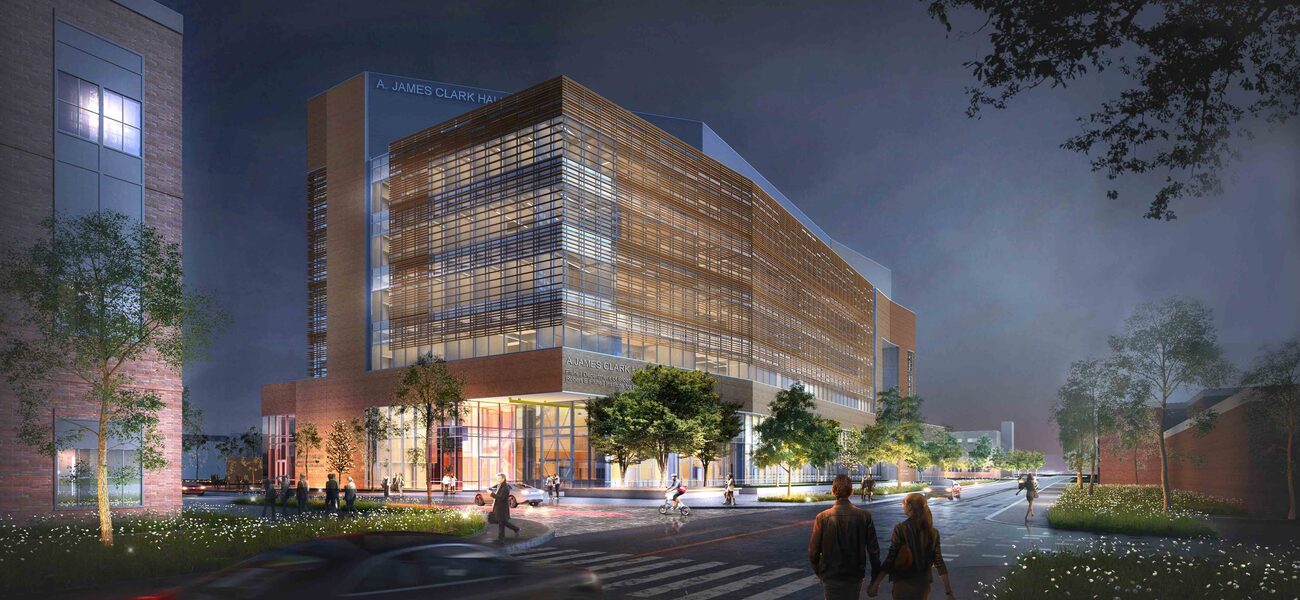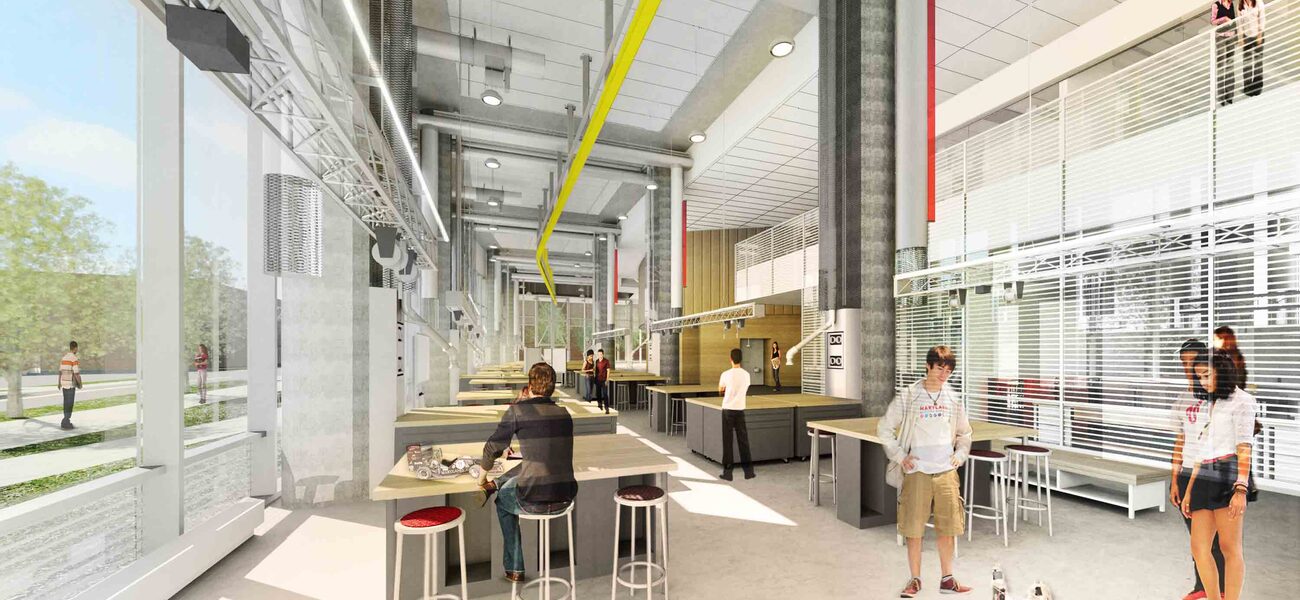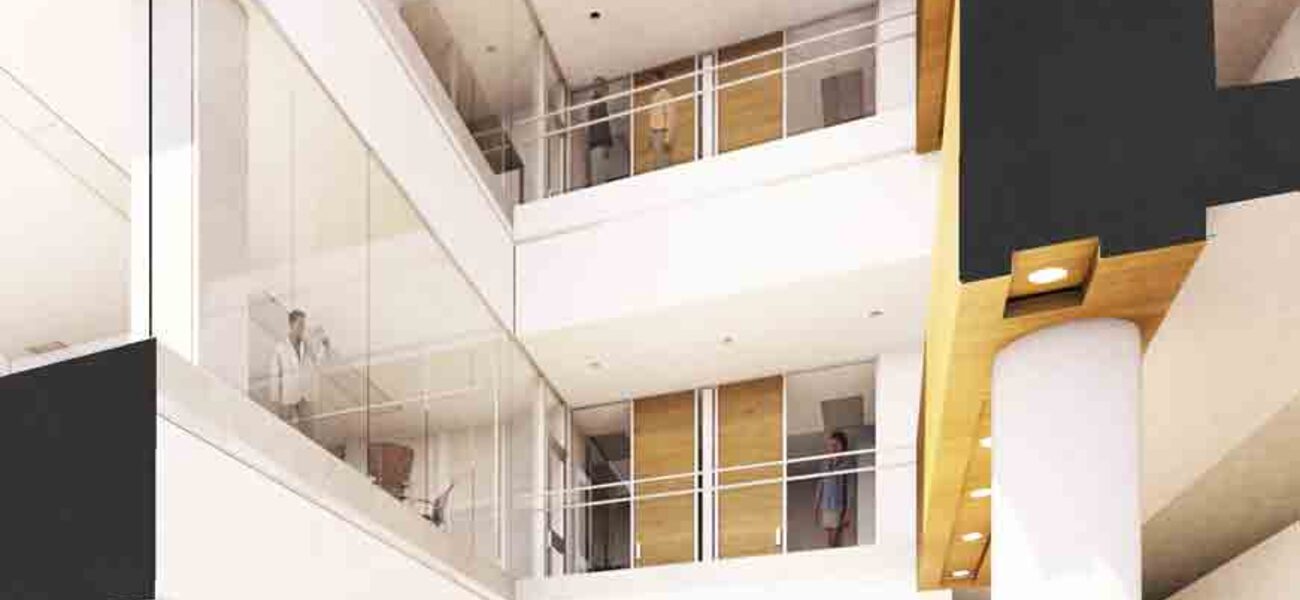The University of Maryland is building a state-of-the-art engineering teaching and research building for the era of convergence science. It is designed to facilitate the practical integration of bioscience, medicine, and engineering to develop new biomedical devices and other health-related advancements. When it opens in 2017, the six-floor, 184,000-sf A. James Clark Hall will serve as a national center for innovation that combines engineering with biology, medicine, and information technology in support of private and government partnerships.
Funded in part by Bob Fischell—whose inventions include the arterial stent and the implantable defibrillator—the building will house the University’s newly created department of bioengineering and the Institute for Medical Devices, in addition to flexible instructional facilities and an onsite vivarium. In addition to supporting the bioengineering school, the transdisciplinary facility will focus on developing practical advancements in biomedical devices, tissue engineering, biofabrication, and drug delivery, among other pursuits.
“It’s termed ‘convergence science’ because we are seeing much more transdisciplinary research happening in applied sciences,” says Jeffrey Schantz, formerly a principal with Jacobs Consultancy, who collaborated on the project. “We live in an era when private funding is increasing, and public funding is decreasing, so there’s more of a drive for applied solutions. Shifting the focus means engineering is not just about making a car or a plane; it’s also about making a molecule, or a structure, or material. Because of that, we have a lot of disciplines involved.”
The facility, designed by Ballinger Architects, will feature two stories of flexible laboratories, open classroom spaces, wet and dry labs, a vivarium, and a host of digital fabrication, 3-D printing, and bioinformatics tools. An imaging suite, with optical laser and magnetic resonance devices, will allow students and faculty to, for example, examine pathogens at the molecular scale to identify how nano-carriers might deliver drugs directly to a tumor.
“The concept is that a device like the stent will end up doing much more than just holding an artery open,” says Bill Bentley, chair of the Fischell Department of Bioengineering. “It will communicate with your cellphone and convey information about your metabolic profile, and what drugs you are taking. These are technologies that combine biology, chemistry, medical science, physics, electrical engineering, and mechanical engineering.”
Leveraging Partnerships
Bioscience, medicine, and engineering have been steadily converging over the past 50 years through advances in the Human Genome Project, the emergence of synthetic biology, and President Obama’s Brain and Behavior initiatives. As a result, the facility’s convergence model is a product of timing and location that leverages regional and national partnerships with private organizations and federal agencies.
“Our focus on biomedical devices is largely because we lack a collocated medical school,” says Darryll Pines, dean of the A. James Clark School of Engineering. “So it made sense for us to focus on devices and then work with clinicians throughout the region testing them in their locations. We are in the nexus of bioscience and biotechnology here, with a number of federal agencies located in our region. We also have something called the Maryland MPower Initiative, which supplies state funding that allows our bioengineering colleagues to collaborate directly with the School of Medicine’s faculty and clinicians.”
“We are getting back to making technology, but we are also trying to transfer that technology into the marketplace through industry partnerships,” says Schantz, “which is all the more important in the current era, when the public is not funding as much, and you need to generate income from those sciences.”
Maker Labs, Innovation Labs, and Process Stations
One of the facility’s most unusual features is the concept of “maker labs”—areas where students and faculty can work on specific problems with direct access to the fabrication laboratories.
“The maker labs are really about getting back to making things,” says Schantz. “They provide functional spaces where you can assemble and test things. Because of the types of devices being developed, you never know where the pieces are going to come from. It may be something you fabricate yourself. It may be something that gets created in a chemistry lab or on a 3D printer. It may be done in a machine shop or a thermoplastics forming lab. The idea is to create instructional labs for doing that right next to open labs with the necessary cores right there. So you can fabricate, assemble, and test a project all in the presence of faculty who are moving through the building.”
An innovation lab also provides high bay studio space for students to work in teams. Power, exhaust, and other services are provided overhead, along with moveable casework and storage, so that the spaces can be easily adapted for other needs. There is also a fully enclosed wet innovation lab.
“There is fundamentally no commons space in this program,” says Craig Spangler, principal at Ballinger. “So we reimagined the innovation lab as the foundation for the social component of the building. It’s sort of a maker commons.”
Instrument connectivity and data sharing are also important considerations in an interdisciplinary neighborhood-based design. The new facility was planned to provide network connectivity for instruments and advanced data management capabilities.
“That’s important because of the types of data streams people are using and the impact big data has on how research is being done,” says Schantz. “Sometimes it doesn’t matter where the data is coming from. It could be from your institution and your instruments, or it could be coming from a partner around the world. The instrument that you are gathering data from is likely hooked up to a network somewhere. But the thing we have to keep in mind is that there will come a day when all of those analytical instruments will be accessible on mobile devices. So the question is, when you can walk around with your laboratory in your pocket, what happens to the building and all the infrastructures?”
As a result, the research spaces have ultra-flexible floor plans, with enclosed central cores that allow for controlled processes, as well as open labs that accommodate research teams of various sizes. Laboratories can be either open or closed, wet or dry, owned or shared.
Changing Metrics
One of the biggest changes in the development of facilities for convergence science is how larger project teams are impacting the way occupancy metrics are benchmarked.
“Right now, there is a big change in the size of the teams,” says Schantz. “When we first started doing this 10 years ago, research teams were typically a P.I. plus maybe eight other people. When we planned this building, it was a P.I. plus 12. Now we are finding that it’s actually going to be a P.I. plus 20 or 30.”
The growth in team size is primarily driven by the way modern research funding is acquired.
“The era is over where you could just depend on your partner in the chemistry department to do that one thing for you,” says Schantz. “Now you need to have teams that bring all the disciplines with them, whether it’s a biophysicist, bioinformaticist, a chemist, and so on.”
Flexible Future
As a transformative generational building, the facility is expected to change over the long term, so adaptability and convertibility will be the foundation for re-programming every space. Because all utilities come down from the ceiling and not up from the floor, converting spaces from wet to dry is relatively simple.
“It’s really just a matter of moving furniture in and out,” says Schantz. “That being said, this is heavy furniture. Even with wheels, it may not be something you’re going to get a couple of grad students to do over the weekend. You might need to call the manufacturer or have somebody from facilities with a lift truck move some of it around. For instance, we’ve gotten to the point where our fume hoods are movable, even though they are connected to the building. So what you really have to plan for is how much infrastructure you need, and how much convenience you want, keeping in mind that infrastructure costs money.”
One of the key factors established in post-occupancy research of other multidisciplinary facilities nationwide is the importance of having spaces where people can interact.
“There absolutely needs to be a social crossroads,” says Spangler. “In this case, the maker commons will become the main social crossroads. It is a big place where students, faculty, and administrators can all interact in the context of convergence science.”
By Johnathon Allen
This report is based on a pair of presentations by Darryll Pines, Craig Spangler, Bill Bentley, and Jeffrey Schantz, at Tradeline’s College and University Science Facilities 2014 conference.


